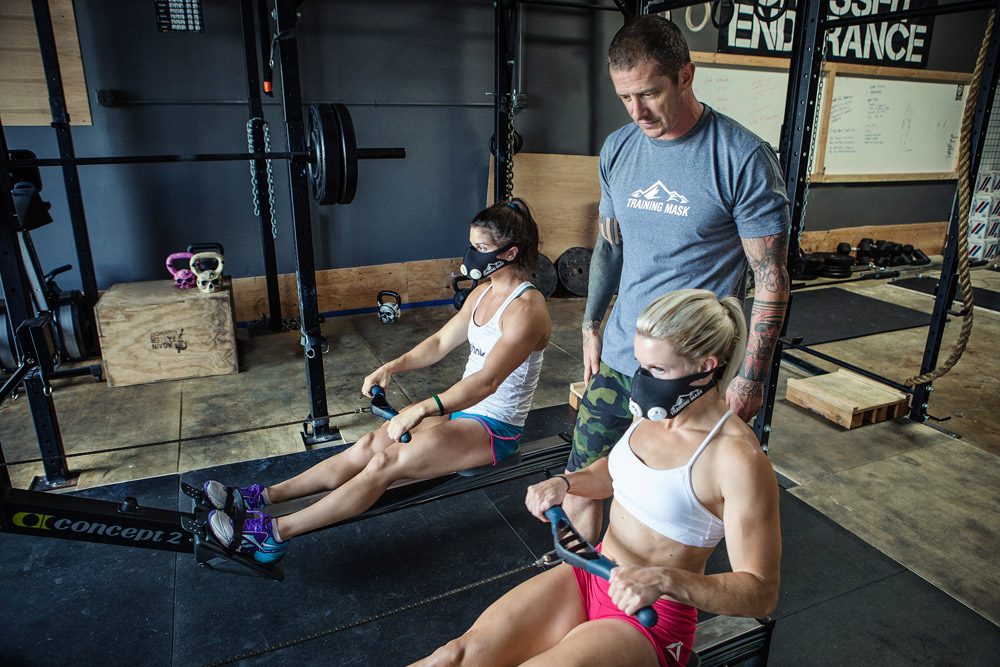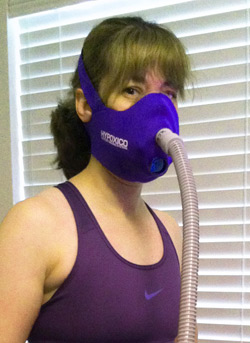
Intermittent hypoxic training (IHT), also known as intermittent hypoxic therapy, is a non-invasive, drug-free technique aimed at improving human performance and well-being by way of adaptation to reduced oxygen.
An IHT session consists of an interval of several minutes breathing hypoxic (low oxygen) air, alternated with intervals breathing ambient or hyperoxic air. This procedure is repeated over a 45- to 90-minute session per day, with a full treatment course taking three to four weeks.
Standard practice is for the patient to remain stationary while breathing hypoxic air via a hand-held mask. The therapy is delivered using a hypoxicator during the day time, allowing the dosage to be monitored. Biofeedback can be delivered using a pulse oximeter.
The phenomenon of IHT is that it delivers a non-damaging training stimulus that naturally triggers a cascade of beneficial adaptive responses without adverse effects. The response is almost instant and is evident at various levels, from systemic down to cellular. Treatment dosage of IHT can be measured and expressed using the hypoxic training index.
It is important to differentiate between physiological adaptations to mild hypoxia and reoxygenation episodes (i.e., the IHT protocol) and frequent nocturnal suffocation awakenings produced by sleep apnea, which might result in various pathologies.
When used for performance enhancement in sports settings IHT improves mitochondrial status, leading to improvements in aerobic and anaerobic performance.
IHT can be beneficial for the treatment of a wide range of degenerative diseases, including:
- Chronic heart and lung diseases
- Hypertension
- Asthma and chronic bronchitis
- Liver and pancreatic diseases
- Anxiety and depression
- Iron-deficiency anaemia
- Lack of energy and fatigue
IHT is contra-indicated in case of:
- Acute somatic and viral diseases
- Chronic obstructive pulmonary disease (COPD-II and COPD-III)
- Chronic diseases with symptoms of decompensation or terminal illness
- Individual intolerance of oxygen insufficiency
- Cancer, unless IHT is prescribed by a doctor
- People with epilepsy, pacemakers or heart arrhythmias, unless treatment (including IHT) is under direct medical supervision.
Although there are no reported adverse effects with IHT, basic treatment protocol suggested by the manufacturer must be followed.
Altitude training has become very popular among athletes as a means to further increase exercise performance at sea level or to acclimatize to competition at altitude. Several approaches have evolved during the last few decades, with “live high-train low” and “live low-train high” being the most popular. This review focuses on functional, muscular, and practical aspects derived from extensive research on the “live low-train high” approach. According to this, subjects train in hypoxia but remain under normoxia for the rest of the time. It has been reasoned that exercising in hypoxia could increase the training stimulus.
Is Hypoxia Training good for Muscles and Exercise Performance
 Hypoxia Training studies published in the past have varied considerably in altitude (2300-5700 m) and training duration (10 days to 8 weeks) and the fitness of the subjects. The evidence from muscle structural, biochemical, and molecular findings point to a specific role of hypoxia in endurance training. However, based on the available performance capacity data such as maximal oxygen uptake (Vo(2)max) and (maximal) power output, hypoxia as a supplement to training is not consistently found to be advantageous for performance at sea level. Stronger evidence exists for benefits of hypoxic training on performance at altitude. “Live low-train high” may thus be considered when altitude acclimatization is not an option. In addition, the complex pattern of gene expression adaptations induced by supplemental training in hypoxia, but not normoxia, suggest that muscle tissue specifically responds to hypoxia. Whether and to what degree these gene expression changes translate into significant changes in protein concentrations that are ultimately responsible for observable structural or functional phenotypes remains open. It is conceivable that the global functional markers such as Vo(2)max and (maximal) power output are too coarse to detect more subtle changes that might still be functionally relevant, at least to high-level athletes. The study has been done by Vogt M1 and Hoppeler H and is available at: http://www.ncbi.nlm.nih.gov/pubmed/20417346
Hypoxia Training studies published in the past have varied considerably in altitude (2300-5700 m) and training duration (10 days to 8 weeks) and the fitness of the subjects. The evidence from muscle structural, biochemical, and molecular findings point to a specific role of hypoxia in endurance training. However, based on the available performance capacity data such as maximal oxygen uptake (Vo(2)max) and (maximal) power output, hypoxia as a supplement to training is not consistently found to be advantageous for performance at sea level. Stronger evidence exists for benefits of hypoxic training on performance at altitude. “Live low-train high” may thus be considered when altitude acclimatization is not an option. In addition, the complex pattern of gene expression adaptations induced by supplemental training in hypoxia, but not normoxia, suggest that muscle tissue specifically responds to hypoxia. Whether and to what degree these gene expression changes translate into significant changes in protein concentrations that are ultimately responsible for observable structural or functional phenotypes remains open. It is conceivable that the global functional markers such as Vo(2)max and (maximal) power output are too coarse to detect more subtle changes that might still be functionally relevant, at least to high-level athletes. The study has been done by Vogt M1 and Hoppeler H and is available at: http://www.ncbi.nlm.nih.gov/pubmed/20417346
Advancing Hypoxic Training in Team Sports: from intermittent hypoxic training to repeated sprint training in hypoxia
Over the past two decades, intermittent hypoxic training (IHT), that is, a method where athletes live at or near sea level but train under hypoxic conditions, has gained unprecedented popularity. By adding the stress of hypoxia during ‘aerobic’ or ‘anaerobic’ interval training, it is believed that IHT would potentiate greater performance improvements compared to similar training at sea level. A thorough analysis of studies including IHT, however, leads to strikingly poor benefits for sea-level performance improvement, compared to the same training method performed in normoxia.
Despite the positive molecular adaptations observed after various IHT modalities, the characteristics of optimal training stimulus in hypoxia are still unclear and their functional translation in terms of whole-body performance enhancement is minimal. To overcome some of the inherent limitations of IHT (lower training stimulus due to hypoxia), recent studies have successfully investigated a new training method based on the repetition of short (<30 s) ‘all-out’ sprints with incomplete recoveries in hypoxia, the so-called repeated sprint training in hypoxia (RSH).
The aims of the present review are therefore threefold: first, to summarise the main mechanisms for interval training and repeated sprint training in normoxia. Second, to critically analyse the results of the studies involving high-intensity exercises performed in hypoxia for sea-level performance enhancement by differentiating IHT and RSH. Third, to discuss the potential mechanisms underpinning the effectiveness of those methods, and their inherent limitations, along with the new research avenues surrounding this topic.The study has been done by Raphaël Faiss, Olivier Girard and Grégoire P Millet is available at: http://bjsm.bmj.com/content/47/Suppl_1/i45.full.html
Video
Disclaimer
The Content is not intended to be a substitute for professional medical advice, diagnosis, or treatment. Always seek the advice of your physician or other qualified health provider with any questions you may have regarding a medical condition.
